Formation of Brown Dwarfs and Protoplanetary Discs in a Star Cluster
The following movies and still images were created from calculations
performed on the UKAFF supercomputer showing the collapse of a gas
cloud to form a cluster of stars, some surrounded by protoplanetary
discs.
| |
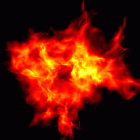 |
|
The first movie shows the full evolution of the system.
Available formats:
AVI for Windows or Unix (57.1MB, high-quality)
Simulation & visualisation by Matthew Bate, University of Exeter.
|
| |
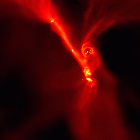 | |
Shorter clip showing the details of the formation of stars and protoplanetary discs.
Available formats:
AVI for Windows or Unix (3.9MB, high-quality)
Simulation & visualisation by Matthew Bate, University of Exeter.
|
| |
Still images
Click on the images below for a larger version
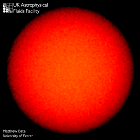 |
|
Clouds of interstellar gas are seen to be very turbulent with
supersonic motions. We begin with such a gas cloud, just over 1
light-year across, and containing 50 times the mass of the Sun. |
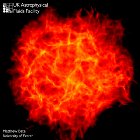 |
|
As the calculation proceeds, the turbulent
motions in the cloud form shock waves that slowly damp the supersonic
motions. |
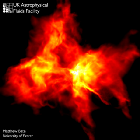 |
|
When enough energy has been lost in some regions of the
simulation, gravity can pull the gas together to form a dense "core".
|
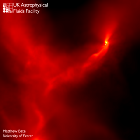 |
|
The gas within this core continues to collapse, forms filamentary
strutures, and breaks up to form very low-mass protostars with about
10 times the mass of Jupiter.
|
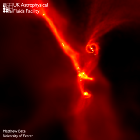 |
|
Some of the remaining gas falls
in around these protostars forming protoplanetary discs and building
up the mass of the protostars. The first protostars to form in this
simulation form a binary, although others form later on their own.
|
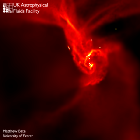 |
|
The discs of gas that form around the protostars contain a lot of mass
and gravity can also form protostars to form within these discs. For
example, around the first binary, 3 objects form. The orbits of these
objects are unstable and they are quickly ejected from the
binary. Because they are ejected from the dense gas just after they
are formed
they are unable to increase their masses by attracting the residual
gas and they become brown dwarfs with masses of 10-40 times that of Jupiter.
Many of the other objects are able to attact enough gas that they become
proper stars. The most massive star in this calculation has about the
same mass as our Sun.
|
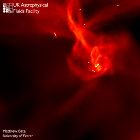 |
|
As the stars and brown dwarfs form, their gravity tends to pull them
together into a close group. They then undergo a series of close
interactions before the group breaks up and the stars fly out of the
cloud and into the rest of the galaxy. During these close interactions
many of the large discs (4-10 times the size of our solar system)
are destroyed. However, some discs survive and would be expected to form
planets, towards the top-left of this image for example.
|
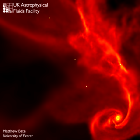 |
|
Another large protoplanetary disc develops as further star
formation begins in the filaments.
|
| |









